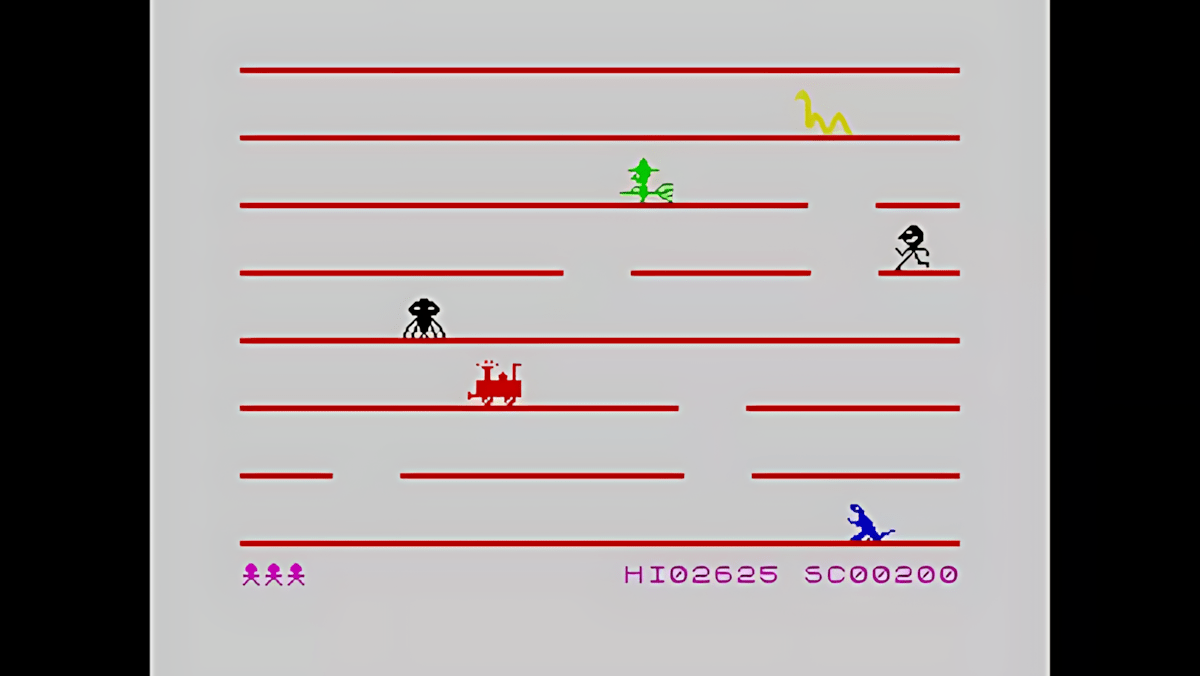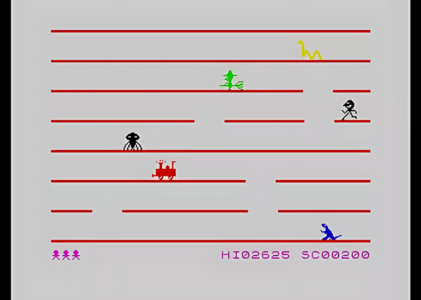Introduction
In the early 1980s, the world of video gaming was rapidly evolving, with various home computers vying for dominance. One of the most memorable systems of this era was the ZX Spectrum, a home computer that became synonymous with gaming in the United Kingdom. Among the many games developed for this platform, “Jumping Jack” stands out as a quintessential example of the creativity and charm that defined early video games. This article delves into the history, gameplay, and legacy of “Jumping Jack,” a game that captured the hearts of many ZX Spectrum enthusiasts.
The Birth of Jumping Jack
Development and Release

“Jumping Jack” was developed by Albert Ball and Stuart C. Ball and published by Imagine Software in 1983. Imagine Software, based in Liverpool, was one of the most influential software houses of the time, known for producing a range of popular titles for the ZX Spectrum and other home computers.
The game’s development was relatively swift, with the Ball brothers leveraging the ZX Spectrum’s capabilities to create a simple yet addictive platformer. The game was written in assembly language, which allowed for greater control over the hardware and better performance, a crucial factor given the limited resources of early home computers.
“Jumping Jack” was developed by Albert Ball and Stuart C. Ball and published by Imagine Software in 1983. Imagine Software, based in Liverpool, was one of the most influential software houses of the time, known for producing a range of popular titles for the ZX Spectrum and other home computers.
The game’s development was relatively swift, with the Ball brothers leveraging the ZX Spectrum’s capabilities to create a simple yet addictive platformer. The game was written in assembly language, which allowed for greater control over the hardware and better performance, a crucial factor given the limited resources of early home computers.
Concept and Design
The concept of “Jumping Jack” was straightforward yet ingenious. Players controlled Jack, a character who had to ascend through a series of floors by jumping through gaps that appeared in them. Each level became progressively more challenging, with faster-moving floors and narrower gaps. The game’s simplicity was its strength, offering an accessible yet increasingly difficult challenge that kept players coming back for more.
Gameplay Mechanics
Controls and Objective
“Jumping Jack” utilized the ZX Spectrum’s keyboard for controls. Players used the left and right arrow keys to move Jack horizontally across the screen and the spacebar to make him jump. The objective was to guide Jack from the bottom of the screen to the top, jumping through gaps in the moving floors above.
Levels and Difficulty
Each level in “Jumping Jack” consisted of five floors that moved horizontally across the screen. Gaps would randomly appear in the floors, and players had to time their jumps precisely to avoid falling off the screen. As players advanced through the levels, the speed of the floors increased, and the gaps became more sporadic and challenging to navigate.
The game’s difficulty curve was well-designed, with early levels serving as a gentle introduction to the mechanics. However, as players progressed, the challenge escalated significantly, requiring quick reflexes and precise timing. This balance of accessibility and difficulty was a hallmark of many successful games of the era.
Scoring and Lives
“Jumping Jack” featured a straightforward scoring system. Players earned points for each floor they successfully jumped through, with additional points awarded for completing levels. The game also included a life system, where players started with three lives. Losing a life occurred when Jack fell off the bottom of the screen or missed a gap. The game ended when all lives were lost, prompting players to strive for higher scores with each attempt.
Visuals and Sound
Graphics
Given the ZX Spectrum’s graphical limitations, “Jumping Jack” made effective use of its available resources. The game’s graphics were simple but functional, with clear and distinct character sprites. Jack himself was represented as a small, animated figure with a distinctive jumping motion. The floors and gaps were depicted using basic lines and blocks, ensuring that the gameplay remained the focal point.
Sound
Sound in “Jumping Jack” was minimal but effective. The ZX Spectrum was not renowned for its audio capabilities, but the game’s developers managed to create a few distinctive sound effects that added to the experience. These included the sound of Jack jumping, the floors moving, and a brief tune that played upon completing a level or losing a life. While primitive by modern standards, these sounds were part of the game’s charm and nostalgia.
Reception and Legacy
Critical Reception
Upon its release, “Jumping Jack” received positive reviews from both critics and players. It was praised for its addictive gameplay, well-designed difficulty curve, and the simplicity of its concept. Many reviewers highlighted the game’s replay value, noting that players would often find themselves attempting “just one more go” to beat their high scores.
Influence and Legacy
“Jumping Jack” became one of the more memorable titles for the ZX Spectrum, contributing to the platform’s reputation as a home for innovative and engaging games. The game’s success demonstrated the potential for simple yet challenging gameplay, influencing the design of future platformers and arcade-style games.
In the years following its release, “Jumping Jack” has been fondly remembered by retro gaming enthusiasts and ZX Spectrum fans. It has been featured in numerous retrospectives and compilations of classic games, ensuring that new generations of players can experience its charm. The game also inspired similar titles on other platforms, cementing its place in the annals of video game history.

Technical Aspects and Programming
Assembly Language and Optimization
“Jumping Jack” was programmed in assembly language, which was common for games of that era due to its efficiency and speed. The ZX Spectrum, with its Z80 processor, required developers to write highly optimized code to make the most of its limited processing power and memory. The Ball brothers skillfully used assembly language to create smooth animations and responsive controls, crucial for a game that relied on precise timing and quick reflexes.
Memory Management
The ZX Spectrum’s base model came with just 16KB of RAM, which posed significant challenges for game developers. “Jumping Jack” had to fit within these constraints, requiring meticulous memory management. The game’s graphics, sound, and gameplay logic all had to be stored in this limited space, which was a testament to the developers’ ingenuity.
Sprite Animation
Animating the main character, Jack, was one of the key technical challenges. The developers created a series of sprite animations to depict Jack’s jumping motion. These sprites had to be small and efficient, using as little memory as possible while still conveying the necessary movement. The result was a character that felt lively and responsive, enhancing the player’s connection to the game.
The Cultural Impact of Jumping Jack
A Snapshot of Early 80s Gaming
“Jumping Jack” is more than just a game; it is a snapshot of early 1980s gaming culture. During this period, home computers like the ZX Spectrum were becoming more accessible, and gaming was transitioning from the arcades to the living room. Games like “Jumping Jack” played a crucial role in this transition, demonstrating that home computers could offer engaging and challenging experiences.
Nostalgia and Retro Gaming
For many who grew up in the 1980s, “Jumping Jack” is a nostalgic reminder of their early gaming experiences. The game’s simplicity and charm evoke memories of a time when video games were a new and exciting form of entertainment. This nostalgia has fueled a thriving retro gaming community, where enthusiasts collect and play classic games on original hardware or through emulators.
Modern Tributes and Remakes
The enduring appeal of “Jumping Jack” has led to various tributes and remakes over the years. Independent developers have created modern versions of the game, often with updated graphics and sound but retaining the core gameplay mechanics. These remakes serve as a testament to the game’s lasting impact and its influence on game design.
Conclusion
“Jumping Jack” is a classic example of the creativity and innovation that defined the early days of video gaming. Developed for the ZX Spectrum by Albert and Stuart Ball, the game captured the imaginations of players with its simple yet challenging gameplay. Its legacy lives on in the hearts of retro gaming enthusiasts and continues to inspire modern game developers. As we look back on the history of video games, “Jumping Jack” stands as a shining example of how a straightforward concept, executed with skill and passion, can create an enduring and beloved classic.

